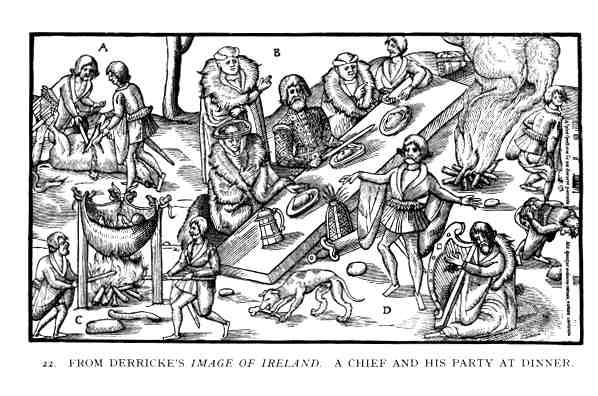
Try Amazon Fresh

|
Late Medieval Ireland |
|
"In the fifteenth, sixteenth, and seventeenth centuries, it was usual, among the general run of people, for unmarried girls to wear the hair
carefully combed out and hanging down loosely on the back: while married women more commonly bound it up round the head, with bright-coloured ribbons and long pins, in
tasteful knots and wreaths: generally with a covering of some kind -- a cap or folded kerchief." (Joyce, Vol. 2, p. 180) The historical costuming list has had a lot of discussion over the years about the construction of the late-period Irish leine. The general consensus is that the sleeve is neither pleated nor has a drawstring along the top -- it's shaped more like the long sleeve of a Japanese kimono, but more rounded at the lower end. The practice of either sewing in pleats or a drawstring comes from an attempt a few decades ago to figure out how to incorporate 6 or more yards of material into the leine. However, given that the material used was probably only about 30 inches wide -- well, that makes a big difference in construction. You could easily use two yards of 30" wide fabric in each sleeve, and another three to four yards in the body of the garment, and not have an overwhelmingly large garment. Moreover, only the very wealthy would have been able to afford lots and lots of extra fabric in their leine. See the last illustration on this page for a good look at the sleeve of a poor man's leine -- it clearly isn't as full as some of the other sleeves on this page, and is shoved up a bit at the elbow. I don't currently have the time to expand on this page, but hope to do so in the future. In the meantime, please see the following web sites: Reconstructing History -- Kass McGann, their historian, has done research in Ireland on clothing in this period. 
'City' woman from Dublin, mid-late 16th c., by de Heere:
Dancing figures on a whalebone book cover from County Dublin, late 16th century:
Kerns (ceatharnaigh), or professional foot-soldiers, from Gaelic Ireland, ca. 1540: |
Copyright Notice:
The Author of this work retains full copyright for this material. Permission is granted to make and distribute verbatim copies of this document for non-commercial private research or educational purposes provided the copyright notice and this permission notice are preserved on all copies.
Clothing of the Ancient Celts - Copyright 1997, M. E. Riley